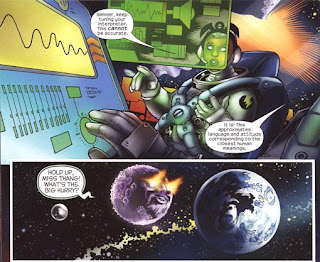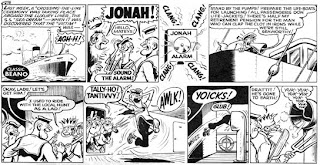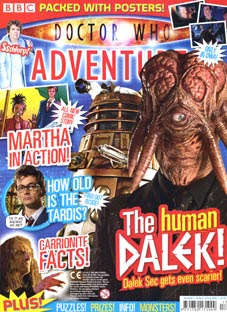 Marvel Adventures The Avengers issue 12: “Ego the Loving Planet” by Jeff Parker (worlds of words), Juan Santacruz (pencils of Pluto), Raul Fernandez (inks of Io), Impacto Studios’ Adriano Lucas (cosmic colour), Dave Sharpe (lightspeed letters) and Mark Paniccia (supernova [editor]), cover by Cameron Stewart and Guru eFX, Marvel Comics, June 2007, 22 pages, US$2.99
Marvel Adventures The Avengers issue 12: “Ego the Loving Planet” by Jeff Parker (worlds of words), Juan Santacruz (pencils of Pluto), Raul Fernandez (inks of Io), Impacto Studios’ Adriano Lucas (cosmic colour), Dave Sharpe (lightspeed letters) and Mark Paniccia (supernova [editor]), cover by Cameron Stewart and Guru eFX, Marvel Comics, June 2007, 22 pages, US$2.99This issue exists for one purpose: to tell a joke about what happens when Ego the Living Planet comes a-courtin’ the Earth. And it does it perfectly. There’s lots of incidental amusement with Spider-Man quips, general abuse of Dr Bruce Banner and the Hulk demanding that Storm reads him a story, but really this is a shaggy dog story with a light-hearted script and bright, clear artwork. There should be more comics like this.

 X-Men First Class issue 8: “The Treasure Hunters” by Jeff Parker (writer), Roger Cruz (artist), Val Staples (colourist), Blambot’s Nate Piekos (letterer) and Mark Paniccia (editor), cover by Marko Djurdjevic, Marvel Comics, June 2007, 25 pages of strip, US$2.99
X-Men First Class issue 8: “The Treasure Hunters” by Jeff Parker (writer), Roger Cruz (artist), Val Staples (colourist), Blambot’s Nate Piekos (letterer) and Mark Paniccia (editor), cover by Marko Djurdjevic, Marvel Comics, June 2007, 25 pages of strip, US$2.99I missed the first seven issues of this eight-issue series because I really don’t like the X-Men. Chris Claremont’s X-Men were the prototype for much that I dislike about modern super-hero comics, dealing with closed communities of super-powered characters who interact only with other super-powered characters, full of angst, soap-opera emotions and storylines that never finish, convoluted continuity and overstretched political metaphors.
But X-Men First Class gets away from all that, returning to Stan Lee and Jack Kirby’s original idea of a school for super-heroes, with their mutant status standing in for adolescent alienation rather than for the Holocaust. Not that there’s much stress on alienation here, because, as with Marvel Adventures The Avengers, this is a Jeff Parker comic, so its heroes are actually likeable. It’s another complete, well-structured tale of modest proportions, in which the X-Men head off to the Congo to find the missing Professor X, and hire Gorilla-Man from Agents of Atlas as their guide.

Mostly, the comic focuses on the X-Men and Gorilla-Man getting to know each other. This enables the creative team to pull off a neat trick. The first page is a yearbook entry with Professor X’s handwritten comments on his pupils. This would seem like a fairly clumsy way of introducing the characters, except that the story also closes with the same yearbook page, this time with Gorilla-Man’s comments, thus tying it all in to the story.
Roger Cruz provides clear but detailed, expressive cartooning which is a real asset to the book. If it wasn’t for a panel on page 2 in which Jean Gray and Scott Summers’s speech balloons have been accidentally swapped over, it would be another example of a comic achieving perfectly what it set out to do.
I’m kicking myself for only picking this up with the last issue, but that’s what trade paperback collections are for, I suppose. And there’s a new series in the works too.
 Classics from the Comics issue 132, by various writers and artists, cover by Ken H Harrison, D C Thompson, 2007, 66 pages of strip, £2.00
Classics from the Comics issue 132, by various writers and artists, cover by Ken H Harrison, D C Thompson, 2007, 66 pages of strip, £2.00On the 300th anniversary of the Union of the Kingdoms of England and Scotland, here’s something from Dundee that has been part of the common culture of children in Britain these past 70 years.
Classics from the Comics reprints strips from the D C Thompson family of children’s humour comics, including The Beano, Dandy, Sparky, Beezer, Nutty, Topper, Cracker and Buzz. This isn’t one of D C Thompson’s digest series, but a full 21cm by 29cm magazine.
The series represented include Dennis the Menace (the British one, obviously), Bully Beef and Chips, Beryl the Peril, Billy Whizz, Fred the Flop, Winker Watson, The Bash Street Kids, Peter Piper, Harum Scarem, Smasher, Some Mummies Do ‘Ave ‘Em, The Three Bears, Ginger, The Whizzers from Ozz, Roger the Dodger, Harry and his Hippo, The Snobbs and the Slobbs, Desperate Dan, Jonah, Colonel Blink, Dirty Dick, Superwitch, Tiny, Minnie the Minx, The Nutters, Nobby, The Banana Bunch, Little Plum, Hungry Horace, Pop Dick and Harry, Jammy Mr Sammy, Mickey the Monkey, Robin Hood’s Schooldays, Baby Crockett, Puss an’ Boots, Dreamy Daniel, Rip van Tinkle, Greedy Pigg, Desert Island Dick, Korky the Cat and Biffo the Bear, as well as several instalments of the adventure strip The Black Sapper, about a master criminal with a tunnelling machine. (Note to any non-British readers who have made it this far: no, I haven’t made any of those up.)
All the strips, except Biffo on the back cover, are reprinted in black and white. They are undated, except when reproduced from a front cover which had the date on it in the first place. They all look to be from the 1950s through to the 1970s.

Artists and writers are also uncredited, but there appears to be work here from Dudley Watkins (Frank Quitely’s hero), Leo Baxendale (such as Robin Hood’s Schooldays, above), Ken Reid (including Jonah, below) and David Law, among others.

The strips contain the usual mix of bad puns, deceit, violence, slapstick and greed. It’s been a long time since I was eight years old, so the appeal here is more to my nostalgia and respect for the technical skill on display than to my sense of humour. If this had been properly marked up with dates and creator credits it would have been of greater historical interest, but it is still fascinating, and quite a bargain at the price.
 Doctor Who Adventures issue 28: “The Skrawn Inheritance” Part 1 by Trevor Baxendale (script), John Ross (art), Adrian Salmon (colours), Paul Vyse (letters) and Moray Laing (editor), BBC Magazines, 26 April – 9 May 2007, 6 pages of strip (out of 36), £2.50
Doctor Who Adventures issue 28: “The Skrawn Inheritance” Part 1 by Trevor Baxendale (script), John Ross (art), Adrian Salmon (colours), Paul Vyse (letters) and Moray Laing (editor), BBC Magazines, 26 April – 9 May 2007, 6 pages of strip (out of 36), £2.50The comic strip feature in Doctor Who Adventures introduces Martha Jones this issue, but she doesn’t make much of an impact. Rose Tyler’s characterisation as a bright outspoken chav was a gift for writers trying to squeeze character bits into short comic strips: Martha’s subtler characterisation isn’t. But the Doctor is spot-on, turning on a sixpence from brooding to babbling and bamboozling. The art is clear, lively and colourful. But, really – a spaceship called the “Tritanic”? An alien race called “the Skrawn”? Who are their enemies, the Laard?

The rest of the issue is made up of photo-features about the current TV series, competitions, quizzes and the like.
No comments:
Post a Comment